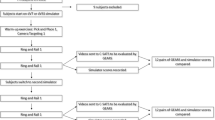Abstract
Background
There is an increasing interest for a test assessing objectively the innate aptitude for surgery as a craft specialty to complement the current selection process of surgical residents. The aim of this study was to quantify the size of individuals with high, average, and low level of innate psychomotor skills among medical students.
Methods
A volunteer sample of 155 medical students, without prior experience with surgical simulator, executed five tasks at a virtual simulator for robot-assisted surgery. They had to reach proficiency twice consecutively in each before moving to the next one. A weighting based on time and number of attempts needed to reach proficiency was assigned to each task.
Results
Nine students (5.8%) out of 155 significantly outperformed all the others on median (i.q.r.) weighted time [44.7 (42.2–47.3) min vs. 98.5 (70.8–131.8) min, p < 0.001], and number of attempts to reach proficiency [14 (12–15) vs. 23 (19–32.75), p < 0.001). Seventeen students (11.0%) scored significantly much worse than the rest on median weighted time [202.2 (182.5–221.0) min vs. 84.3 (65.7–114.4) min, p < 0.001], and number of attempts [42 (40–48) vs. 22 (17.25–28), p < 0.001]. Low correlation between simulator scores and extracurricular activities, like videogames and musical instruments, was found.
Conclusions
The test successfully identified two groups straddling the large cohort with average innate aptitude for psychomotor skills: (i) innately gifted and (ii) with scarce level. Hence, exercises on a virtual simulator are a valid test of innate manual dexterity and can be considered to complement the selection process for a surgical training program, primarily to identify individuals with low innate aptitude for surgery and advise them to consider specialization in other (non-craft) medical specialties.


Similar content being viewed by others
References
Mattar SG, Alseidi AA, Jones DB, Jeyarajah DR, Swanstrom LL, Aye RW, Wexner SD, Martinez JM, Ross SB, Awad MM, Franklin ME, Arregui ME, Schirmer BD, Minter RM (2013) General surgery residency inadequately prepares trainees for fellowship: results of a survey of fellowship program directors. Ann Surg 258:440–449
Louridas M, Szasz P, Montbrun S, Harris KA, Grantcharov TP (2017) Optimizing the selection of general surgery residents: a national consensus. J Surg Educ 74:100–107
Moglia A, Ferrari V, Morelli L, Melfi F, Ferrari M, Mosca F, Cuschieri A (2014) Distribution of innate ability for surgery amongst medical students assessed by an advanced virtual reality surgical simulator. Surg Endosc 28:1830–1837
Louridas M, Szasz P, de Montbrun S, Harris KA, Grantcharov TP (2016) Can we predict technical aptitude? A systematic review. Ann Surg 263:673–691
Kramp KH, van Det MJ, Hoff C, Veeger NJ, ten Cate Hoedemaker HO, Pierie JP (2016) The predictive value of aptitude assessment in laparoscopic surgery: a meta-analysis. Med Educ 50:409–427
Grantcharov TP, Funch-Jensen P (2009) Can everyone achieve proficiency with the laparoscopic technique? Learning curve patterns in technical skills acquisition. Am J Surg 197:447–449
Bridges M, Diamond DL (1999) The financial impact of teaching surgical residents in the operating room. Am J Surg 177:28–32
Gallagher AG, Satava RM (2002) Virtual reality as a metric for the assessment of laparoscopic psychomotor skills. Learning curves and reliability measures. Surg Endosc 16:1746–1752
Moglia A, Ferrari V, Morelli L, Ferrari M, Mosca F, Cuschieri A (2016) A systematic review of virtual reality simulators for robot-assisted surgery. Eur Urol 69:1065–1080
Hung AJ, Zehnder P, Patil MB, Cai J, Ng CK, Aron M, Gill IS, Desai MM (2011) Face, content and construct validity of a novel robotic surgery simulator. J Urol 186:1019–1024
Lee JY, Mucksavage P, Kerbl DC, Huynh VB, Etafy M, McDougall EM (2012) Validation study of a virtual reality robotic simulator-role as an assessment tool? J Urol 187:998–1002
Cuschieri A, Francis N, Crosby J, Hanna GB (2001) What do master surgeons think of surgical competence and revalidation? Am J Surg 182:110–116
Buckley CE, Kavanagh DO, Gallagher TK, Conroy RM, Traynor OJ, Neary PC (2013) Does aptitude influence the rate at which proficiency is achieved for laparoscopic appendectomy? J Am Coll Surg 217:1020–1027
Cope DH, Fenton-Lee D (2008) Assessment of laparoscopic psychomotor skills in interns using the MIST virtual reality simulator: a prerequisite for those considering surgical training? ANZ J Surg 78:291–296
Glassman D, Yiasemidou M, Ishii H, Somani BK, Ahmed K, Biyani CS (2016) Effect of playing video games on laparoscopic skills performance: a systematic review. J Endourol 30:146–152
Lin D, Pena G, Field J, Altree M, Marlow N, Babidge W, Hewett P, Maddern G (2016) What are the demographic predictors in laparoscopic simulator performance? ANZ J Surg 86:983–989
Harbin AC, Nadhan KS, Mooney JH, Yu D, Kaplan J, McGinley-Hence N, Kim A, Gu Y, Eun DD (2016) Prior video game utilization is associated with improved performance on a robotic skills simulator. J Robot Surg. https://doi.org/10.1007/s11701-016-0657-x
Shee K, Ghali FM, Hyams ES (2017) Practice makes perfect: correlations between prior experience in high-level athletics and robotic surgical performance do not persist after task repetition. J Surg Educ. https://doi.org/10.1016/j.jsurg.2016.12.008
Moglia A, Perrone V, Ferrari V, Morelli L, Boggi U, Ferrari M, Mosca F, Cuschieri A (2017) Influence of videogames and musical instruments on performances at a simulator for robotic surgery. Minim Invasive Ther Allied Technol 26:129–134
Gallagher AG, Neary P, Gillen P, Lane B, Whelan A, Tanner WA, Traynor O (2008) Novel method for assessment and selection of trainees for higher surgical training in general surgery. ANZ J Surg 78:282–290
Acknowledgements
Fondazione Arpa (http://www.fondazionearpa.it) supported the study and donated dV-Trainer simulator to EndoCAS Center. The authors thank Mr. Rick Corlett and Mr. Andreas Koch from Mimic Corporation for the technical support during the study.
Author information
Authors and Affiliations
Corresponding author
Ethics declarations
Disclosures
Andrea Moglia, Luca Morelli, Vincenzo Ferrari, Mauro Ferrari, Franco Mosca, Alfred Cuschieri have no conflicts of interest or financial ties to disclose.
Rights and permissions
About this article
Cite this article
Moglia, A., Morelli, L., Ferrari, V. et al. Distribution of innate psychomotor skills recognized as important for surgical specialization in unconditioned medical undergraduates. Surg Endosc 32, 4087–4095 (2018). https://doi.org/10.1007/s00464-018-6146-8
Received:
Accepted:
Published:
Issue Date:
DOI: https://doi.org/10.1007/s00464-018-6146-8




